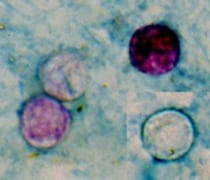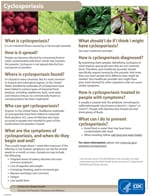Disease
Symptoms of cyclosporiasis begin an average of 7 days (range, 2 days to ≥2 weeks) after ingestion of sporulated oocysts (the infective form of the parasite).
Symptoms of cyclosporiasis may include the following:
- Watery diarrhea (most common)
- Loss of appetite
- Weight loss
- Cramping
- Bloating
- Increased gas
- Nausea
- Fatigue
Other symptoms that may occur but are less common include the following:
- Vomiting
- Low-grade fever
If a person ill from cyclosporiasis is not treated, symptoms can persist for several weeks to a month or more. Some symptoms, such as diarrhea, can return; and some symptoms, such as fatigue, may continue after the gastrointestinal symptoms have gone away. The infection usually is not life threatening. Some infected persons do not have any symptoms, particularly persons from areas where cyclosporiasis is endemic, such as tropical and subtropical regions.
 DPDx
DPDx